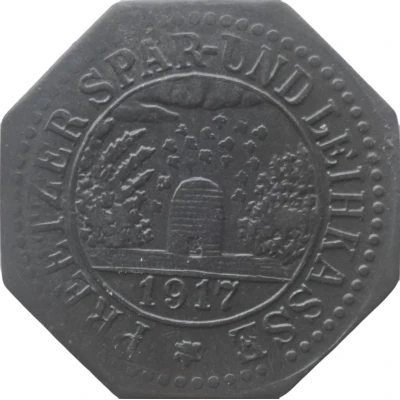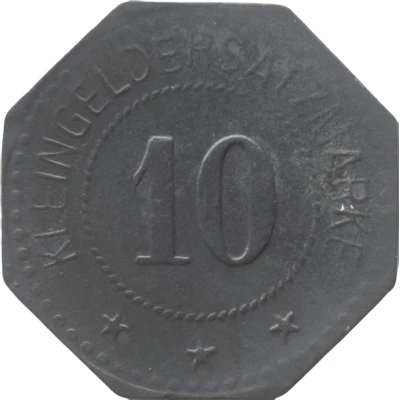


© Willem63 (CC BY-NC-SA)
10 Pfennigs - Preetz
1917 year| Zinc | 2.0 g | 20.6 mm |
| Issuer | City of Preetz (Prussian province of Schleswig-Holstein) |
|---|---|
| Issuing entity | Preetzer Spar und Leihkasse |
| Emperor | William II (Wilhelm II) (1888-1918) |
| Type | Standard circulation coin |
| Year | 1917 |
| Value | 10 Pfennigs (10 Pfennige) (0.10) |
| Currency | Mark (1914-1924) |
| Composition | Zinc |
| Weight | 2.0 g |
| Diameter | 20.6 mm |
| Thickness | 0.9 mm |
| Shape | Octagonal (8-sided) |
| Technique | Milled |
| Orientation | Medal alignment ↑↑ |
| Demonetized | Yes |
| Updated | 2024-10-04 |
| Numista | N#350113 |
|---|---|
| Rarity index | 94% |
Reverse
Pearl rim, legend surrounding rope circle with denomination centered
Script: Latin
Lettering:
KLEINGELDERSATZMARKE
10
★ ★ ★
Edge
Plain
Interesting fact
The 10 Pfennigs coin from Preetz (Prussian province of Schleswig-Holstein) made of Zinc weighing 2.0 g is interesting because it was produced during a time of economic and political turmoil in Germany. The coin was minted in 1917, during World War I, when the country was facing severe economic challenges, including inflation and a shortage of metals. As a result, the German government was forced to use alternative metals, such as zinc, to produce coins. This coin is a unique example of how a country's currency can be impacted by historical events.